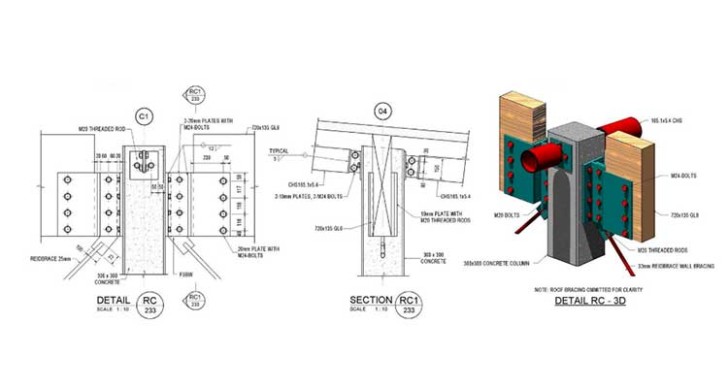Zigurat Global Institute of Technology
Blog / BIM & Construction Management
Structural BIM: Uses and Cases
Categories

IN TODAY’S POST, BIM ENGINEER JOSÉ CARLOS LINO WILL CONTINUE FROM WHERE WE LEFT OFF WITH THE FUNDAMENTALS OF STRUCTURAL BIM AND GIVE A MORE DETAILED ACCOUNT OF THE STRUCTURAL BIM USES.
Where can we use BIM methodology in structural engineering? Similar to other construction sector professionals, Building Information Modeling (BIM) helps structural engineers to make more informed design decisions, automate documentation and present more constructible designs, while also improving the collaboration with other stakeholders and making the project delivery faster. In what follows, you can check out some of the uses of BIM in structural engineering:
Structural BIM design
In structural design, we can use very simple conceptual approaches, like tools (e.g. Rhino, Dynamo) for changing geometric shapes in modeled shapes. Support Tools: Rhino (Architecture): - free parametric modeling tool; - Interoperability with the structural model, via IFC format. Automatic calculation of earth movements Automatic quantification of earthworks is another use of BIM in structural engineering. From the topographic to the shape of the different levels where we can automatically determine the earth’s movements. What we should know here is that: The import process from CAD to BIM ground is automated; The CAD-BIM import process only works if the topographic points in CAD have altimetric coordinates, ie 3D representation of the ground; Automated Calculation existing between the ground and adapted ground.
Structural BIM analysis
Another use, of course, is the structural analysis. The interlink between the physical model and the analytical model is very important. The geometric model is based on a model by ones. These objects relate parametrically, thus linking all the template information. The analytical model absorbs this information to be conveyed to the software structural calculation. The BIM bidirectional link between a platform and a structural analysis tool allows the designer to test various structural solutions (in more primary phases of the project) in a rapid and automated manner. This iterative process of data respects and preserves the information defined in both software. 
Image source: AEC Magazine
In the image above, on the left side, there’s the physical model (the model that represents the geometry). On the right side, there’s the analytical model, where we have strains, reactions, deflections, displacements. Example: Revit Structure &Robot Structural Analysis: This connection allows structural engineers to send parts of the structural model for structural analysis tools and vice versa. This flexibility allows engineers to work with the structure in separate analysis models. We used to split the calculations between gravity loads (permanent loads, temperature etc.) and lateral loads (seismic loads and wind loads).
 Image source: Autodesk
Image source: Autodesk
Situations: Systems of vertical and horizontal loads; metallic systems and reinforced concrete systems; Evaluation of specific elements in the structure. Automatic production of drawings and views (2D/3D) This use is very advanced in certain types of structures, e.g. steel structures, but less advanced in other structures, e.g. concrete structures. There’s still a lot of work till reaching a proper drawing of Automatic extraction of quantities and budget estimate The quantity takeoff is very relevant for the structural engineer especially in the early phases since the accurate measurement of building materials is becoming increasingly important. Several case studies have concluded that the process measurements in BIM are more reliable compared to traditional methods. BIM tools also allow measuring more in less time. Thank to BIM, we would have the quantities and the budget: 
Image: José Carlos Lino
Phasing
Structural engineering sometimes needs phasing as part of the analytical process, for instance in bridges. In bridges, each phase of construction needs to be calculated, needs to be understood for the engineer to have the right stress, deflection, etc. Phasing 4D connected with the management is another practical application of BIM in a project. Multidisciplinary Coordination (3D) Detecting clash detection, the coordination, the compatibility among all the areas and structures is another use. So BIM permits to verify the compatibility between products and the automatic detection and early resolution of conflicts, e.g. between the architect and the engineer.
Structural detailing
Using BIM for steel connections, wood connections, etc. is also a possibility. The example is of a mixed structure with concrete, steel and wood.
 Image: José Carlos Lino
Image: José Carlos Lino
In conclusion, we can say that structural engineers should take deliberate steps to incorporate BIM into structural workflows. The idea is to look and move ahead collectively to leverage the BIM process in ways that are beneficial to the structural engineers themselves and to the project as a whole.
Autor: José Carlos Lino



